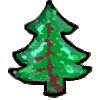Shoots bearing spirally arranged bifacial leaves. Observed width of axes
up to 5 mm; axes together with leaves up to 30 mm. Leaves slightly overlapping,
straight. Different shapes and dimensions of leaves indicating heterophylly:
(1) Shape ovate; observed dimensions up to 8 mm long, 4 mm wide; (2) Shape oblong
to lanceolate; observed dimensions up to 20 mm long, 5 mm wide. Sofar observed
leaf bases of (1) and (2) decurrent and completely covering the axes and apices
obtuse.
Ovuliferous dwarf-shoot up to 14 mm long, 20 mm wide and provided with
approximately thirteen sterile scales, triangular in shape with acuminate apex.
The three fertile scales are oval with obtuse apex, places of ovule attachment,
approximately 3 mm in diameter, on lateral scales scarcely shifted to adaxial
side of the dwarf-shoot; on median scale the place of ovule attachment is
distally bordered by a protuberance.
Stomata on adaxial leaf surfaces and scales arranged in more or less
irregular, often interrupted rows, on abaxial leaf surfaces scattered. Basal
part of dwarf-shoot non-stomatiferous. Frequency of stomata/mm² ranging from 50
(type 1) to 25 (type 2), measured halfway along the abaxial leaf surfaces; on adaxial
surfaces frequency of stomata considerably higher. Adjacent stomatal complexes,
sometimes sharing a subsidiary cell, occurring.
Stomatal complexes approximately 90 µm in diameter, smaller on adaxial
surfaces; guard cells slightly sunken, mostly longitudinally orientated; 5-10
subsidiary cells, narrow trapezoid; inner part of subsidiary cells forming a shallow
pit and bearing horizontal or inward pointing converging solid papillae.
Subsidiary cells, especially on abaxial surfaces often stronger cutinized than
epidermal cells, proximal and anticlinal walls thickened, distal walls straight
to concave, sometimes slightly overlapping epidermal cells. Mean number of subsidiary
cells per stomatal complex, measured on a single abaxial surface, ranging from
7-7.6, on adaxial surfaces this number is smaller.
Epidermal cells isodiametric, obviously larger on abaxial leaf surfaces,
especially of leaves of type (2), often only stretched on leaf bases, sometimes
provided with centrally placed solid papillae. Anticlinal walls on leaves
approximately 6 µm wide.
Scarious margin; cuticle thick, especially on type (1); hypodermis only
observed on scales of ovuliferous dwarf-shoot.

Add new comment